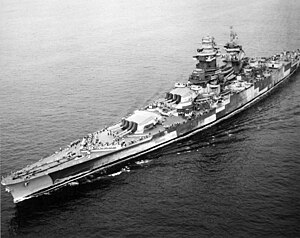 Richelieu after her refit in the United States, c. September 1943
| |
| Class overview | |
|---|---|
| Name | Richelieu class |
| Builders | |
| Operators | |
| Preceded by | Dunkerque class |
| Succeeded by | Alsace class (planned) |
| Subclasses | Gascogne |
| Built | 1935–1955 |
| In service | 1940–1970 |
| Planned | 4 |
| Completed | 2 |
| Cancelled | 2 |
| Scrapped | 2 |
| General characteristics (Designed configuration) | |
| Type | Fast battleship |
| Displacement | |
| Length | 247.85 m (813 ft 2 in) o/a |
| Beam | 33.08 m (108 ft 6 in) |
| Draft | Full load: 9.9 m (32 ft 6 in) |
| Installed power |
|
| Propulsion | |
| Speed | 32 knots (59 km/h; 37 mph) |
| Range | 9,500 nautical miles (17,600 km; 10,900 mi) at 15 knots (28 km/h; 17 mph) |
| Complement | 1,569 |
| Armament |
|
| Armor |
|
| Aircraft carried | 4 × Loire 130 seaplanes |
| Aviation facilities | 2 × catapults |
| General characteristics (Richelieu 1943 refit) | |
| Displacement |
|
| Draft | Full load: 10.68 m (35 ft) |
| Complement | 1,930 |
| Sensors and processing systems |
|
| Armament |
|
| General characteristics (Jean Bart as completed) | |
| Displacement |
|
| Draft | 10.9 m (36 ft) |
| Complement | 2,220 |
| Sensors and processing systems |
|
| Armament |
|
The Richelieu class were fast battleships built for the French Navy between the 1930s and 1950s. Initially two ships were ordered in 1935 in response to Italian orders for the Littorio-class battleships the previous year. The Richelieus were based on the preceding Dunkerque class, but scaled up to accommodate more powerful 380 mm (15 in) guns and armor to protect them from guns of the same caliber. To keep the ships within the displacement limits imposed by the Washington Naval Treaty, they featured the same concentrated arrangement as the Dunkerques for the main battery: two quadruple gun turrets placed forward. They also incorporated new, more compact boilers that allowed for a shorter hull (which required less heavy armor) for the desired top speed. After Germany ordered two Bismarck-class battleships, France responded with another pair of Richelieus, to be built to modified designs. The first, Clemenceau, would have received modified secondary and anti-aircraft batteries, while Gascogne would have had had her superfiring main battery turret shifted aft, along with other changes. Clemenceau was never completed, and Gascogne was never laid down. The Richelieus were the last battleships built for the French Navy.
Neither of the two completed members of the class had been completed by the outbreak of World War II. Richelieu was finished shortly before the French defeat in the Battle of France, while Jean Bart was hurriedly prepared to be ready to go to sea during the campaign. Both vessels fled to French colonies in Africa: Richelieu steamed to Dakar and Jean Bart went to Casablanca. Work on Clemenceau and Gascogne stopped after the Germans occupied France. In mid-1940, Richelieu was attacked twice and damaged by British forces attempting to coerce the crew to defect to Free France, while Jean Bart was badly damaged by American forces during Operation Torch in November 1942. After the French African colonies shifted to Free French control, Richelieu was taken to the United States to be repaired and modernized, while Jean Bart was not completed. Richelieu saw active service with the British Home Fleet in early 1944 before being transferred to the Eastern Fleet later that year. There, she took part in numerous operations against Japanese forces in the Indian Ocean. She was present for the Japanese surrender of Singapore at the end of the war.
After the war, Richelieu took part in the initial campaign to restore control of French Indochina before returning to France, where she saw limited activity into the early 1950s. During this period, the French Navy discussed proposals to complete Jean Bart or convert her into an aircraft carrier, ultimately settling on the former. Jean Bart was finally commissioned in 1955, thereafter taking part in the French intervention in the Suez Crisis in November 1956. Her career proved to be a short one, and she was placed in reserve in 1957. Both vessels were used as training and barracks ships into the 1960s; Richelieu was sold to ship breakers in 1968 and Jean Bart followed her in 1970.